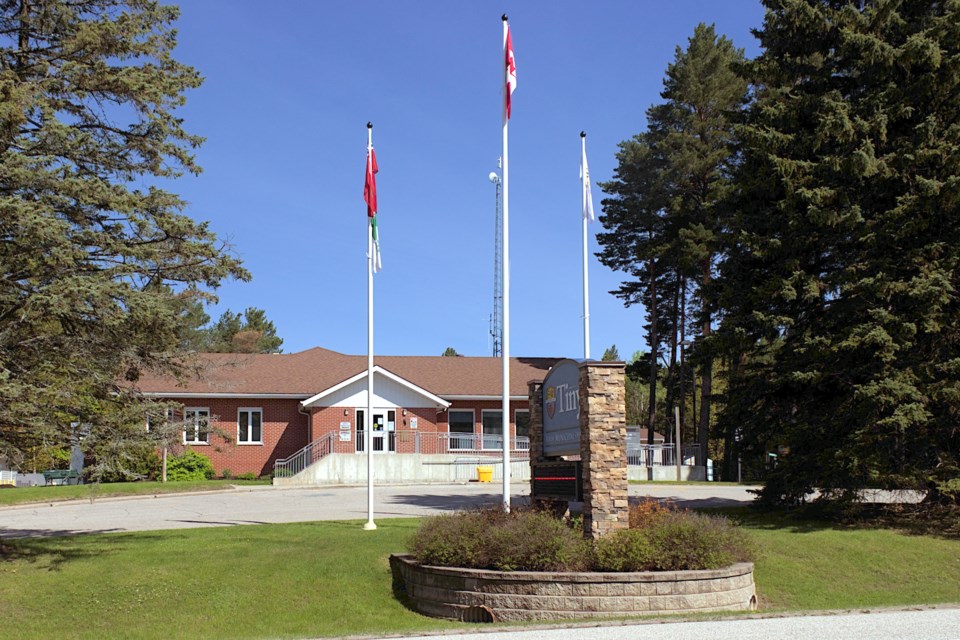What began as a look into dry hydrants within Tiny Township became a larger discussion on firefighting water availability, water shuttling costs and how including Thunder Beach and Toanche could benefit residents within five kilometres of those sources.
A request for Tiny staff to look into dry hydrant installation and other technologies was made by Coun. Steffen Walma in April, but “quickly changed paths” once the matter was explored further, according to fire chief/emergency services director Dave Flewelling.
Flewelling described that a map was developed through the municipal IT department which showed “what properties within the municipality are within five kilometres of an approved water source currently. Once that was completed,” Flewelling said, “we could see that a good portion of our shoreline properties are already within five kilometres of an approved water source.”
Several maps accompanied the fire services report in the recent committee of the whole meeting, showcasing municipal hydrants, pumphouses, non-municipal hydrants, a look at Toanche Park as a possible water source, and a summary map incorporating all township hydrants.
“Many other areas of the township lack the availability of an adequate water supply for firefighting,” said Flewelling. “We also have a limited number of cisterns and dry hydrants, but installing dry hydrants is complicated. Our shoreline conditions make it hard to maintain the necessary water levels, and cost estimates for these types of installations are significant.
“Dry hydrants come with numerous challenges. While it’s crazy to say that we’re surrounded by Georgian Bay, it is difficult to say the least to find a suitable location to install one of these,” Flewelling added.
Tankers typically deliver water to fire scenes in rural areas, where a municipality like Tiny with an accreditation for superior tanker shuttle service can reduce resident insurance rates. A dry hydrant relies on drawing from a reliable and unpressurized water reservoir, as compared to a hydrant which pushes water into pipes and hoses.
Prospective cost estimates by Tiny to install a dry hydrant project ranged around $220,000, according to the report, with the cost of a minimum-sized 95,000-litre cistern estimated to be $265,000.
Flewelling proposed recommendations in the report, including: installing reservoirs, adding cisterns and looking to Toanche Park as a possible expansion.
“While we can't have fire hydrants in every rural setting, these improvements can significantly enhance our firefighting efforts and help lower insurance rates for our residents. We need to plan and budget for these upgrades as part of our infrastructure revitalization goals,” said Flewelling.
Coun. Kelly Helowka asked how many cisterns would be a critical need for the township to investigate immediately, which Flewelling replied would be up to the appetite of council along with budget constraints.
“The Toanche area is heavily populated; Farlain Lake is heavily populated; we have a new development that's coming online in Toanche with another 80 or so residential lots, and we have no firefighting supply of water in that area,” said Flewelling.
“Currently we truck it in from a great distance away, and we have since I've been part of this department for 20-odd years now. Installing a reservoir as part of that project, if it’s a requirement of the project anyways, would greatly supplement our service in that area.”
When asked by Walma what improvements would make hydrants more accessible for firefighting, public works director Tim Leitch replied that an upcoming water master plan to be finalized soon would address that aspect as well as related infrastructure elements.
Walma requested that efforts be put into the 2025 budget to address the lacking areas.
“We've got two holes in the north end of the township that have higher densities than other places in the municipality,” said Walma. “Can we put money into this? I know that our water systems are usually user-fee maintained and created, but in my opinion, hydrants protect everybody in the municipality.”
Mayor Dave Evans agreed with Walma, with attention to how the dry hydrant exploration had flourished into an infrastructure conversation.
“I think this is the proverbial peeling the onion and finding what's underneath,” said Evans. “This is opening up the whole – our long-term 10-, 20-year plan of where we go; which ultimately is direction given by council, and the investment in our infrastructure. Water and firefighting are one part of it, so is our buildings and septage that we're dealing with right now.”
Evans added that once the township’s septage issues had been addressed and with the water master plan complete, looking at the expansion of water services would be a concurrent view for council to take.
Said Helowka: “I think it’s incumbent upon this council and future councils to ensure that all Tiny residents have the best available way to deal with any fires in their residential neighborhood… and we'll look at it at budget time and hopefully we'll be able to come up with some long-term solutions.”
On insistence of council, staff were directed to report back with financial implications for up to three options at the 2025 budget, which would support water supply for firefighting.
The firefighting water supplies report, including maps of water supply driving distances within the municipality, can be viewed on the agenda page on the Township of Tiny website.
Archives of council meetings are available to view on the township’s YouTube channel.
